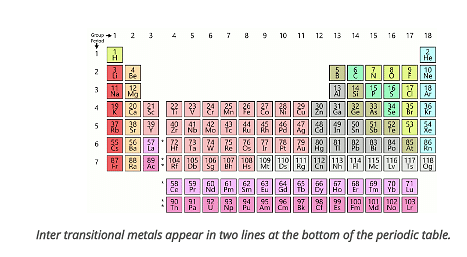What are the different oxidation states exhibited by the lanthanoids?
Solution and Explanation
In the lanthanide series, +3 oxidation state is most common i.e., Ln(III) compounds are predominant. However, +2 and +4 oxidation states can also be found in the solution or in solid compounds.
Top Questions on d -and f -Block Elements
- What is the spin magnetic moment of Cr(III) in Bohr Magnetons?
- AIIMS Paramedical - 2025
- Chemistry
- d -and f -Block Elements
- Among the following outermost electronic configurations of transition metals, which one shows the highest oxidation state?
- CBSE CLASS XII - 2025
- Chemistry
- d -and f -Block Elements
- Highest oxidation numbers for chromium and manganese:
- AIIMS Paramedical - 2025
- Chemistry
- d -and f -Block Elements
- Choose the correct ascending order of ionization energy for Zn, Cu, Ag:
- AIIMS Paramedical - 2025
- Chemistry
- d -and f -Block Elements
- Evaluate these statements about transition metals:
- AIIMS Paramedical - 2025
- Chemistry
- d -and f -Block Elements
Questions Asked in CBSE CLASS XII exam
- Madhavan, Chatterjee and Pillai were partners in a firm sharing profits and losses in the ratio of 2 : 1 : 2. On 31stMarch, 2024, their Balance Sheet was as follows :
Balance Sheet of Madhavan, Chatterjee and Pillai as at 31st March, 2024
On the above date, the firm was dissolved and the following transactions took place :Liabilities Amount (₹) Assets Amount (₹) Creditors 1,10,000 Cash at Bank 4,05,000 Outstanding Expenses 17,000 Stock 2,20,000 Mrs. Madhavan’s Loan 2,00,000 Debtors 95,000 Chatterjee’s Loan 1,70,000 Less: Provision for Doubtful Debts (5,000) Capitals: Madhavan – 2,00,000 Land and Building 1,82,000 Chatterjee – 1,00,000 Plant and Machinery 1,00,000 Pillai – 2,00,000 Total 9,97,000 Total 9,97,000
Debtors were taken over by the creditors in full settlement of their claim.
Madhavan agreed to pay Mrs. Madhavan’s loan.
50% of the stock was taken over by Chatterjee at 10% less than the book value. The remaining stock was sold at a profit of 20%.
Land and Building was taken over by Pillai for \(₹1,00,000\) and Plant and Machinery was sold as scrap for \(₹20,000\).
Realisation expenses \(₹17,000\) were paid by cheque.
Prepare Realisation Account.- CBSE CLASS XII - 2025
- Dissolution of Partnership Firms
- State Kirchhoff’s laws. Apply these laws to find the values of current flowing in the three branches of the given circuit.

- CBSE CLASS XII - 2025
- Kirchhoff's Laws
On the basis of the following hypothetical data, calculate the percentage change in Real Gross Domestic Product (GDP) in the year 2022 – 23, using 2020 – 21 as the base year.
Year Nominal GDP Nominal GDP (Adjusted to Base Year Price) 2020–21 3,000 5,000 2022–23 4,000 6,000 - CBSE CLASS XII - 2025
- National Income Accounting
- A double convex lens of glass has both faces of the same radius of curvature 17 cm. Find its focal length if it is immersed in water. The refractive indices of glass and water are 1.5 and 1.33 respectively.
- The matrix $A = \begin{bmatrix} \sqrt{5} & 0 & 0 \\ 0 & \sqrt{2} & 0 \\ 0 & 0 & \sqrt{5} \end{bmatrix}$ is an:
Concepts Used:
Lanthanoids

Lanthanoids are at the top of these two-row, while actinoids are at the bottom row.
Properties of Lanthanoids
Lanthanoids are inclusive of 14 elements, with atomic numbers 58-71:
- Cerium - Xe 4f1 5d1 6s2
- Praseodymium - Xe 4f3 6s2
- Neodymium - Xe 4f4 6s2
- Promethium - Xe 4f5 6s2
- Samarium - Xe 4f6 6s2
- Europium - Xe 4f7 6s2
- Gadolinium - Xe 4f7 5d1 6s2
- Terbium - Xe 4f9 6s2
- Dysprosium - Xe 4f10 6s2
- Holmium - Xe 4f11 6s2
- Erbium - Xe 4f12 6s2
- Thulium - Xe 4f13 6s2
- Ytterbium - Xe 4f14 6s2
- Lutetium - Xe 4f14 5d1 6s2
These elements are also called rare earth elements. They are found naturally on the earth, and they're all radioactively stable except promethium, which is radioactive. A trend is one of the interesting properties of the lanthanoid elements, called lanthanide contraction.